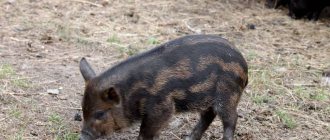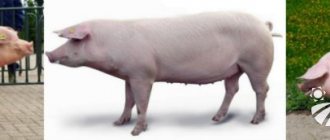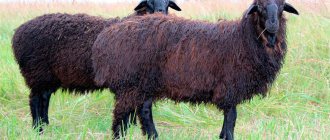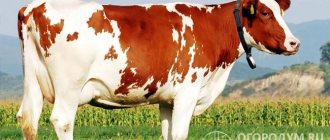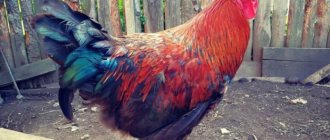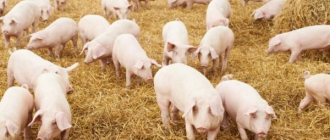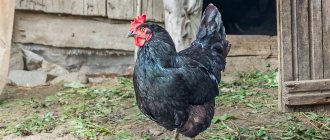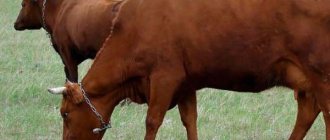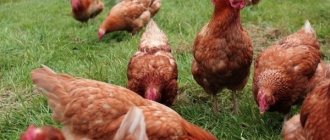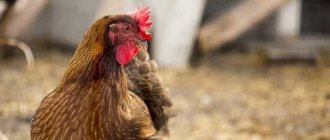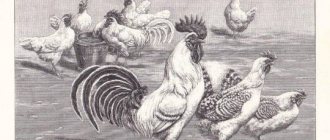The Yorkshire pig breed, developed in the 19th century in Great Britain, is now in demand among Russians, who first became acquainted with it in the post-war years. The fruit of the labor of English breeders is worthy of attention - these pigs are distinguished by their high productivity, unpretentious disposition, and they produce tender and tasty marbled meat. Let's consider the characteristics of the breed - its advantages and disadvantages, external features and rules of care.
Yorkshire pig breed
Origin
The Yorkshire pig breed was developed in the 19th century and officially introduced by English farmer Joseph Tooley at the Windosa Agricultural Exhibition in 1851. Farmers immediately appreciated the new type of pig.
Joseph Tuley lived in Yorkshire - hence the name of the breed. The Yorkshire pig was the result of crossing representatives of the white Leicester and the Chinese and English long-eared pigs. Getting a new breed of bacon became the goal of the English farmer’s life and brought him fame and an impressive income.
Yorkshire piglets were brought to Russia only after the war and immediately became quite popular. Today, the Yorkshire pig breed is the fourth most common breed in the world. There are about 1.5 million individuals of this species in Russia.
History of breeding
In the mid-19th century, English amateur farmer Joseph Tuley worked to improve the qualities of local breeds by crossing long-eared, Leiter and Chinese white pigs. Trying to combine all the positive qualities, the livestock breeder obtained offspring with precocity of young animals, resistance to diseases and unique fattening properties.
Tuley, through systematic crossing of closely related animals, managed to achieve strengthening and consolidation of useful characteristics, thus obtaining a new breed with unique characteristics. The very appearance of the Yorkshire pigs amazed participants at the annual agricultural exhibition in 1851, where the breed was first introduced to the general public.
With particularly large sizes, the body of a purebred pig is distinguished by its leanness without signs of obesity. Proper maintenance and fattening lead to harmonious weight distribution and uniform, moderate fat deposition. The Yorkshire's body, sleek and toned, was very different from the appearance of other pigs of the time.
Thanks to its high rate of weight gain, ability to adapt to different conditions, and fertility, the breed quickly gained popularity in Britain and spread throughout the world. Tuley's pigs became the name of the county where the amateur pig farmer's livestock farm was located. The farmer, thanks to many years of hard work, received a good fortune, and the species began to be called Yorkshire.
The breed is still considered one of the best and has a universal purpose: special fattening allows you to obtain a large percentage of fat. But the main direction in breeding is lean, tender meat and layer-by-layer distribution of layers of fat and pulp in the product.
Characteristics and description
The Yorkshire pig breed has a massive, but slender and fairly fit body without a sagging belly. Piglets of this species do not appear obese. The head is small, the ears are erect, their tips look forward or slightly in different directions, the neck is short and muscular, the shoulders are massive and wide, smoothly turning into a straight back, the body is elongated, powerful legs, large hooves, the hams contain a lot of meat, there is almost none on the body skin folds. Yorkshire pigs are white in color and have very little hair, which is evenly distributed.
Pigs reach a weight of 100 kg by the age of 7 months, while, for example, representatives of the Landrace species reach 6 months. An adult male Yorkie weighs about 350 kg, a female – about 250 kg. The body length is 175-180 cm and 165-170 cm, respectively.
By nature, pigs are not at all aggressive, they are calm, good-natured and friendly. They also adapt well to climatic conditions, feel great in a herd, and can be kept not only in a pigsty, but also in an open pen.
External characteristics of the Landrace pig
The breed and hybrids based on it are distinguished by a strong physique and classic meat forms. Adult wild boars reach two meters in length with a chest circumference of about 1.5 meters. Sows are noticeably shorter - no more than 1.6 meters, but the chest circumference remains the same.
When describing a Landrace pig, it is always noted that its body has a distinctly elongated and slightly torpedo-shaped geometry with dense and wide hams. If the “tail” of a torpedo is the back part of the animal, then the role of its “nose” is a disproportionately small head with large ears hanging over the eyes. It is noteworthy that the neck is quite massive and is noticeably larger in diameter than the head itself. Thanks to such external outlines, Danish pigs are so recognizable that it is not so easy to confuse them with another breed.
Landraces have a straight back and a rather narrow chest. The legs are of medium length and generally quite proportional to the rest of the body. Therefore, pigs remain quite mobile even in adulthood, when they gain considerable weight.
Since the Landrace breed is based on a white pig from England, most piglets are born with the same uniform light pink skin color and white hair, which, by the way, is quite rare and short. However, there are also individuals with a pockmarked (white-black) color, which is not considered a reason for culling the animal.
As for character, according to reviews from owners, Landraces are quite peaceful and obedient, and rarely show aggression. At the same time, the animals are alert and active, so it is difficult to call them phlegmatic.
How to choose the right piglets when purchasing?
The choice of Yorkshire piglets must be approached with great responsibility when purchasing. After all, if you buy a sick or weak pig, you can not only waste money, but also infect the existing livestock.
When buying piglets, you should take those that are more than a month old and weigh at least 5 kg. It is advisable to take piglets from winter or early spring farrowing. In the summer it is easier, cheaper and more profitable to keep and feed animals. Preference should be given to individuals with a long body. In this case, the pig will grow quickly, gain weight well, and the meat will be lean, with a thin layer of fat.
The following factors indicate good health and excellent physical condition of the piglet:
- the head is large and heavy, the profile is straight;
- the ears are thin and pink;
- the jaws close well, the bite is correct;
- the legs are strong, bony and straight-set;
- shiny hooves;
- the chest is wide;
- back wider than shoulders, straight or arched;
- withers without depressions;
- the belly does not sag;
- the tail is bent into a ring;
- the butt is clean (dirty indicates diarrhea, therefore the pig is sick with something);
- the bristles are smooth and shiny, tightly adjacent to the skin;
- skin without spots or damage;
- the patch is pink, wet, cool to the touch;
- breathing is even and deep, there is no cough or wheezing;
- from 70 to 88 respiratory movements per minute;
- active and mobile behavior;
- a good appetite.
Even if the purchased piglets meet all the previous points, they should not be immediately released into a common pigsty. It is necessary to keep the “new ones” in a quarantine pen for some time to make sure that they do not develop any diseases.
Breeding and farrowing
Not every female is suitable for the role of a sow. When deciding to choose a pig for farrowing, you should pay attention to its maternal qualities and the ability to have a large amount of milk to feed the cubs. The future sow should have well-developed mammary glands and 5-8 pairs of nipples. It should be large, weighing more than a hundredweight.
In order for the piglets to meet the characteristics of the breed, the expectant mother must have the appropriate exterior:
- strong legs and dull hooves;
- wide chest;
- straight or arched, non-sagging back;
- correct bite;
- The female should not get sick with rhinitis, as this disease is passed on to the offspring.
The duration of pregnancy in pigs is 3.5-4 months. At this time, she should pay maximum attention. She needs rest, fresh air, plenty of water and fortified food. Vitamins and proteins must be supplied to the body in large quantities. In winter, when there is no green mass, the diet is enriched with boiled root vegetables.
A few days before farrowing, the sow's character changes. She becomes restless, often grunts, and makes a nest-like structure out of the litter. The appearance also changes: the sides droop and the genitals swell.
During childbirth, the pig lies belly up and copes with everything on its own. However, you should not let the process take its course. The owner must monitor the birth and, if necessary, call a veterinarian for help.
A sow gives birth to 10-12 piglets, sometimes 14. The weight of one piglet is 900-1000 grams. Farrowing lasts up to two hours.
After childbirth you must:
- remove mucus covering the body of piglets using coarse natural fabric;
- wipe your nose;
- cut the umbilical cord and treat the wound with iodine;
- provide piglets with access to their mother to receive milk. It is in the first hour after birth that babies should drink mother's milk to protect the body from infections. If it is not enough, it is necessary to supplement the offspring with specialized milk formulas. If the sow behaves restlessly after giving birth, it is better to attach the piglets to the udder after 2-3 hours. At this time, they should be removed from their mother, placed in a box;
- a stillborn piglet should be given artificial respiration;
- remove the placenta and umbilical cord from the cage.
It is best to feed a suckling sow barley.
The sow is ready for the next mating in three weeks. However, there is no need to rush. It is better to wait until she stops feeding the cubs. Artificial formulas for feeding will not allow you to fully gain weight and will lead to diseases.
Conditions of detention and care
Russian and foreign pig breeders love Yorkshire pigs for their unpretentiousness to the conditions of keeping, rearing and care. The most basic thing that Yorkies require is an indoor space that will protect the animals from cold, drafts and sun, and a fenced area for walking in the fresh air.
Do not forget that representatives of the Yorkshire breed are quite large, strong and powerful. They can easily tear down a fragile fence. Therefore, it is worth taking care of a strong fence for the pig pasture.
One of the peculiarities of the Yorkshire breed is its light, delicate skin, which can get sunburned quite quickly in the sun. Therefore, it is also necessary to provide a canopy or shelter from the sun in the walking area.
And, of course, do not forget about regular visits to the veterinarian and vaccination of the livestock in order to avoid outbreaks of diseases and epidemics.
Content Features
An important feature of keeping Yorkshire pigs is the need for grazing to obtain quality meat. To carry out such care, several rules must be followed:
- Piglets tend to dig up fences, and adult animals can break them down with their weight. Therefore, when setting up a pig run, fences should be well reinforced.
- It is worth considering in advance the possibility of shading the yard on sunny days. The Yorkshire's soft, pink skin with sparse stubble is prone to overheating and even sunburn.
- In winter, at low temperatures, walking is carried out no longer than 60 minutes. It is acceptable for pigs to remain in a warm pigsty all the time until the weather gets warmer, but the quality of the meat may suffer from the animals' lack of exercise.
Otherwise, Yorkshires do not have any special preferences and can quickly adapt to different conditions.
Comment! Pedigree sows are capable of bearing and feeding more than 10 piglets. Heavy lactation can last up to 3 months, but babies begin to be fed a few weeks of age.
Feeding
Like any other breed, Yorkshire pigs require care and a quality diet. Due to the fact that they gain weight quite quickly, you need to pay enough attention to the food. Although in general they are not picky and can even live in pasture conditions.
The “menu” should include:
- vegetables;
- cereals;
- juicy green food;
- porridge;
- concentrates;
- vitamins and minerals;
- compound feed
Important! For bacon, piglets are slaughtered for about a year, and for marbled meat, older piglets are slaughtered. Fattening methods for different purposes also vary.
If Yorkshire piglets are fattened on bacon, then from 2.5 to 5.5 months their diet should consist of cereals, grains, potatoes and other vegetables, fish and dairy products, hay and fresh herbs. The animal's daily weight gain should be no more than 500 g. From the age of 5.5 months until slaughter, piglets' feed should consist of concentrates, root vegetables, proteins and vegetables. During this period, the animal should gain 600 g or more per day.
If fattening is used for marbled meat, then protein must be introduced into the diet of piglets that have reached a weight of 100 kg. Every 10-12 days, the amount of concentrates in the feed should be increased by 0.25-0.3 feed units. In this case, the increase in the animal’s weight will be about 800 g per day.
Fattening
If the animal is not planned to be used for breeding purposes, then it is important that it reaches a good slaughter weight as quickly as possible. At first, piglets are fed 5 times a day; as they grow, the number of meals decreases. As Yorkshire pigs age, they begin to eat less frequently, but in larger portions. Sometimes piglets are given treats, such as acorns, between meals.
The type of fattening is selected depending on what the farmer ultimately wants to get: a lot of meat or a large amount of lard. In summer it is useful to let pigs out for a walk. If piglets are planned to be fattened for lard, then feed with a high carbohydrate content should predominate in their diet. They contain a large amount of energy, so pigs quickly gain fat.
If piglets are fattened for meat, then their diet should contain a sufficient amount of protein feed. You can also feed animals with succulent food: fresh cut grass, vegetables. If a farmer does not have time to prepare a diet for pigs, then he can buy ready-made feed.
Reproduction
Female Yorkshire breeds become sexually mature at 10-12 months. This breed is highly fertile. During one farrowing, from 10 to 14 fairly large piglets (about 1 kg) are born. At the same time, the sow is able to feed her piglets for 3-4 months. In addition, Yorkshire females are very attentive and caring towards their offspring.
Piglets quickly gain weight, and by 1-2 months of age it is about 20 kg. By 5-7 months, the weight of a pig can reach 100 kg. For 1 kg of weight gain, approximately 4.5 kg of feed is consumed. But you shouldn’t fatten animals too quickly and intensively, this can lead to excessive obesity, and the resulting meat will no longer be of such high quality.
Productivity
Very productive and in demand among suppliers. It produces valuable so-called marbled pork - tender meat with small layers of fat. Yorkshire is considered universal in terms of productivity; it is a meat breed. Piglets up to one year old are fed for meat or bacon; larger and older piglets are fattened for lard meat.
Yorkshire piglets sometimes suffer from erysipelas. This disease is expressed in dark, scaly spots on the skin and patches. This disease is treated with special ointments and requires strict quarantine. When buying a new animal, do not immediately introduce it into the herd; let it sit in a separate pen.
Yorkshire is a prolific breed, usually a litter of 10-12 piglets. Piglets are born large, approximately one kilogram each, and by a month they reach a weight of 20 kilograms. By 10 months, with unlimited feeding, the weight increases to 200 kilograms or more. Typically, sows of this breed reach a weight of more than 200 kilograms, and boars more than 300. But this is considered undesirable, since the proportion of fat increases sharply, due to which the quality of the meat decreases. But the main purpose of raising and breeding Yorkshire pigs is still valuable and expensive meat.
In addition, Yorkshire pigs have the leanest pork meat. To obtain it, one-year-old young animals weighing approximately 100 kilograms are slaughtered; older and more massive individuals produce fatty pork.
A Yorkshire sow gives birth to up to 12 piglets in one litter.
Advantages and disadvantages
Each breed of pig has its own advantages and disadvantages. The undoubted advantages of the Yorkshire breed are as follows:
- Precocity.
- High fertility.
- Intensive growth and weight gain.
- Endurance.
- Strong immunity.
- Unpretentiousness in maintenance and feeding.
- Possibility of keeping in pasture conditions.
- High quality marbled meat (65-70% yield).
Despite all the advantages of Yorkshire pigs, they also have several disadvantages:
- Very delicate sensitive light skin. In the southern regions, pigs burn quite quickly in the sun.
- The risk of severe obesity and, as a result, deterioration in the quality characteristics of meat. If the diet is too intense and unbalanced, Yorkshire pigs become fat and there is much more fat than meat.
Characteristics of the Yorkshire pig breed
The Yorkshire pig species is one of the most popular for breeding and the most expensive for selling young animals. According to reviews from farmers and breeders, the following advantages of the breed can be highlighted:
- High yield of premium lean meat. Possibility of fattening for meat and fat use.
- Fast growth, large size of adult animals. Seven-month-old piglets weigh about 100 kg.
- Unpretentiousness in nutrition, omnivorous, good adaptation when changing location.
- Fertility, non-aggressiveness, excellent maternal qualities of sows.
- High survival rate, rapid piglet weight gain. Large sizes of newborn Yorkshires.
- Strong immunity in both adult pigs and piglets.
Among the shortcomings of the breed, the tenderness of the skin is noted, which determines the Yorkshire's sensitivity to frost and heat. These disadvantages are not considered critical and do not create problems with the proper organization of wintering and walking pigs.
Comment! In a temperate climate, beyond the Urals, in the north of the country, Yorkshires gain equally good gains, providing them with a warm room in winter.
Reviews from real owners
Reviews from owners of Yorkshire pigs are generally positive, but pig farmers often complain about the pigs’ sun-sensitive skin and their not very high frost resistance:
Nikusya: Yorkies are growing well here. But they don’t tolerate long cold weather very well. By the way, they don’t care about a short drop in temperature. It is necessary, of course, to protect it from drafts. And make sure it's not damp. Well, it depends on the climate; I still wouldn’t recommend starting one in Siberia.
Anna: they are the best of all, I already bought them myself. Their meat is marbled, they don’t scream like ordinary whites, and they eat much less. There's also a little lard. Guys just need to be castrated right away if they are to be used for meat later. It’s better not to keep them in the sun; they burn naturally like people, even with sour cream.
Breed diseases
Yorkshire pigs have a strong immune system, so they rarely get sick. But even good health can be undermined by improper living conditions and poor, unbalanced feeding. In this case, Yorkshire pigs may develop rickets or vitamin deficiency. Young animals born in winter or spring suffer especially often from these ailments.
Animals can also contract a skin disease called erysipelas. With this disease, rashes appear on the ears, face and legs. They bother pigs, who are itchy and nervous. Sick animals may experience hyperthermia. It is not recommended to treat erysipelas on your own; it is better to invite a veterinarian.
